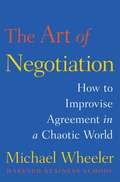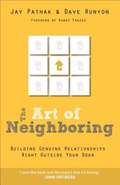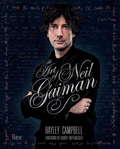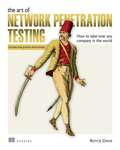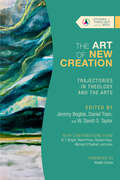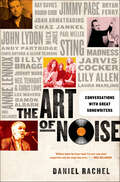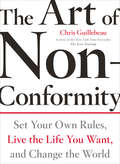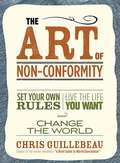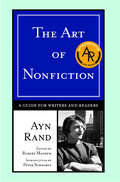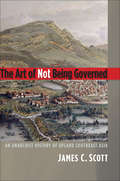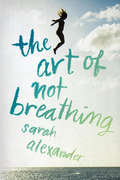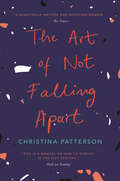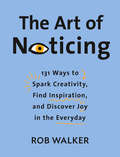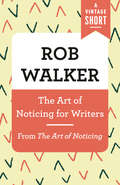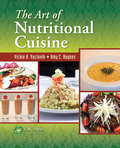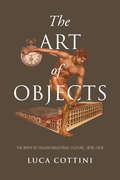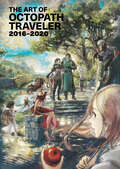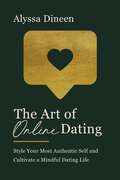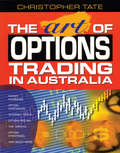- Table View
- List View
The Art of Natural Cleaning: Tips and techniques for a chemical-free, sparkling home (Art Of Ser.)
by Rebecca SullivanThis handy little guide is the perfect companion for anyone who wants to keep their home sparklingly clean without resorting to chemical products. Rebecca draws on traditional cleaning techniques, bringing them up to date to suit the modern home. Taking the time to create your own cleaning products, from floor polish to washing up liquid, creates a more mindful approach to the home and encourages greater respect and care for our surroundings.With just a few simple ingredients, such as salt, bicarb, lemons and essential oils, your home can be clean, fresh and fragrant, as well as environmentally friendly.This inspiring guide is a must for anyone interested in living a simpler, more purposeful life.
The Art of Natural Cleaning: Tips and techniques for a chemical-free, sparkling home (Art of series)
by Rebecca SullivanThis handy little guide is the perfect companion for anyone who wants to keep their home sparklingly clean without resorting to chemical products. Rebecca draws on traditional cleaning techniques, bringing them up to date to suit the modern home. Taking the time to create your own cleaning products, from floor polish to washing up liquid, creates a more mindful approach to the home and encourages greater respect and care for our surroundings.With just a few simple ingredients, such as salt, bicarb, lemons and essential oils, your home can be clean, fresh and fragrant, as well as environmentally friendly.This inspiring guide is a must for anyone interested in living a simpler, more purposeful life.
The Art of Negotiation
by Michael WheelerA member of the world-renowned Program on Negotiation at Harvard Law School introduces the powerful next-generation approach to negotiation. For many years, two approaches to negotiation have prevailed: the "win-win" method exemplified in "Getting to Yes" by Roger Fisher, William Ury, and Bruce Patton; and the hard-bargaining style of Herb Cohen's "You Can Negotiate Anything. " Now award-winning Harvard Business School professor Michael Wheeler provides a dynamic alternative to one-size-fits-all strategies that don't match real world realities. "The Art of Negotiation" shows how master negotiators thrive in the face of chaos and uncertainty. They don't trap themselves with rigid plans. Instead they understand negotiation as a process of exploration that demands ongoing learning, adapting, and influencing. Their agility enables them to reach agreement when others would be stalemated. Michael Wheeler illuminates the improvisational nature of negotiation, drawing on his own research and his work with Program on Negotiation colleagues. He explains how the best practices of diplomats such as George J. Mitchell, dealmaker Bruce Wasserstein, and Hollywood producer Jerry Weintraub apply to everyday transactions like selling a house, buying a car, or landing a new contract. Wheeler also draws lessons on agility and creativity from fields like jazz, sports, theater, and even military science.
The Art of Neighboring: Building Genuine Relationships Right Outside Your Door
by Jay Pathak Dave RunyonWhen Jesus was asked to sum up everything into one command, he said to love God with everything we have and to love our neighbors as ourselves. Most of us have turned this simple idea of loving our neighbors into a nice saying, putting it on bumper stickers and refrigerator magnets and then going on with our lives without actually putting it into practice. What would happen if every follower of Jesus took the Great Commandment literally? Is it possible that the solution to our society's biggest issues has been right under our noses for the past two thousand years?
The Art of Neil Gaiman: The Story Of A Writer With Handwritten Notes, Drawings, Manuscripts, And Personal Photographs
by Neil Gaiman Hayley CampbellNovelist, comics writer, scriptwriter, poet, occasional artist - a master of several genres and inadvertent leader of many cults - there are few creative avenues Neil Gaiman hasn't ventured down. From unforgettable books like The Ocean at the End of the Lane and American Gods to ground-breaking comics and graphic novels like The Sandman and Violent Cases; from big screen fantasies like Coraline to small screen epics like Doctor Who; and from short stories to songwriting, stage plays to radio plays, journalism to filmmaking, and all points in-between, The Art of Neil Gaiman is the first comprehensive, full-colour examination of Gaiman's work to date.Author Hayley Campbell, a close friend of Neil's since she was a small child, spent many months rummaging through Neil's attic to source the never-before-seen manuscripts, notes, cartoons, drawings and personal photographs for this book; these are complemented by artwork and sketches from all of his major works and his own intimate recollections. Each project is examined in turn, from genesis to fruition, and positioned in the wider narrative of Gaiman's creative life, affording unparalleled access to the inner workings of the writer's mind.Utterly comprehensive, lavishly illustrated, The Art of Neil Gaiman is the fully authorised account of the life and work of one of the greatest storytellers of all time.
The Art of Network Penetration Testing: How to take over any company in the world
by Royce DavisThe Art of Network Penetration Testing is a guide to simulating an internal security breach. You&’ll take on the role of the attacker and work through every stage of a professional pentest, from information gathering to seizing control of a system and owning the network.Summary Penetration testing is about more than just getting through a perimeter firewall. The biggest security threats are inside the network, where attackers can rampage through sensitive data by exploiting weak access controls and poorly patched software. Designed for up-and-coming security professionals, The Art of Network Penetration Testing teaches you how to take over an enterprise network from the inside. It lays out every stage of an internal security assessment step-by-step, showing you how to identify weaknesses before a malicious invader can do real damage. Purchase of the print book includes a free eBook in PDF, Kindle, and ePub formats from Manning Publications. About the technology Penetration testers uncover security gaps by attacking networks exactly like malicious intruders do. To become a world-class pentester, you need to master offensive security concepts, leverage a proven methodology, and practice, practice, practice. Th is book delivers insights from security expert Royce Davis, along with a virtual testing environment you can use to hone your skills. About the book The Art of Network Penetration Testing is a guide to simulating an internal security breach. You&’ll take on the role of the attacker and work through every stage of a professional pentest, from information gathering to seizing control of a system and owning the network. As you brute force passwords, exploit unpatched services, and elevate network level privileges, you&’ll learn where the weaknesses are—and how to take advantage of them. What's inside Set up a virtual pentest lab Exploit Windows and Linux network vulnerabilities Establish persistent re-entry to compromised targets Detail your findings in an engagement report About the reader For tech professionals. No security experience required. About the author Royce Davis has orchestrated hundreds of penetration tests, helping to secure many of the largest companies in the world. Table of Contents 1 Network Penetration Testing PHASE 1 - INFORMATION GATHERING 2 Discovering network hosts 3 Discovering network services 4 Discovering network vulnerabilities PHASE 2 - FOCUSED PENETRATION 5 Attacking vulnerable web services 6 Attacking vulnerable database services 7 Attacking unpatched services PHASE 3 - POST-EXPLOITATION AND PRIVILEGE ESCALATION 8 Windows post-exploitation 9 Linux or UNIX post-exploitation 10 Controlling the entire network PHASE 4 - DOCUMENTATION 11 Post-engagement cleanup 12 Writing a solid pentest deliverable
The Art of New Creation: Trajectories in Theology and the Arts (Studies in Theology and the Arts Series)
by Jeremy Begbie W. David O. Taylor Daniel Train, Jeremy Begbie, W. David O. Taylor Daniel TrainThe biblical themes of creation and new creation are inextricably bound to each other.
The Art of Noise: Conversations with Great Songwriters
by Daniel RachelTHE ART OF NOISE offers an unprecedented collection of insightful, of-the-moment conversations with twenty-seven great British songwriters and composers. They discuss everything from their individual approaches to writing, to the inspiration behind their most successful songs, to the techniques and methods they have independently developed to foster their creativity. Contributors include: Sting * Ray Davies * Robin Gibb * Jimmy Page * Joan Armatrading * Noel Gallagher * Lily Allen * Annie Lennox * Damon Albarn * Noel Gallagher * Laura Marling * Paul Weller * Johnny Marr * and many more Musician-turned-author Daniel Rachel approaches each interview with an impressive depth of understanding—of the practice of songwriting, but also of each musician's catalog. The result is a collection of conversations that's probing, informed, and altogether entertaining—what contributor Noel Gallagher called "without doubt the finest book I've ever read about songwriters and the songs they write." The collected experience of these songwriters makes this book the essential word of songwriting—as spoken by the songwriters themselves.
The Art of Non-Conformity: Set Your Own Rules, Live the Life You Want, and Change the World
by Chris GuillebeauIf you've ever thought, "There must be more to life than this," The Art of Non-Conformity is for you.Based on Chris Guillebeau's popular online manifesto "A Brief Guide to World Domination," The Art of Non-Conformity defies common assumptions about life and work while arming you with the tools to live differently. You'll discover how to live on your own terms by exploring creative self-employment, radical goal-setting, contrarian travel, and embracing life as a constant adventure.Inspired and guided by Chris's own story and those of others who have pursued unconventional lives, you can devise your own plan for world domination-and make the world a better place at the same time.
The Art of Non-conformity: Set Your Own Rules, Live the Life You Want, and Change the World
by Chris GuillebeauIf you've ever thought, 'There must be more to life than this,' The Art of Non-Conformity is for you. Based on Chris Guillebeau's popular online manifesto 'A Brief Guide to World Domination,' The Art of Non-Conformity defies common assumptions about life and work while arming you with the tools to live differently. You'll discover how to live on your own terms by exploring creative self-employment, radical goal-setting, contrarian travel, and embracing life as a constant adventure. Inspired and guided by Chris's own story and those of others who have pursued unconventional lives, you can devise your own plan for world domination-and make the world a better place at the same time.
The Art of Non-Conversation: A Re-examination of the Validity of the Oral Proficiency Interview
by Marysia JohnsonThe purpose of this book is to provide answers to two fundamental questions. The first is a practical one, and it represents the main focus of the book: Is the Oral Proficiency Interview a valid instrument for assessing language speaking proficiency? The second is a theoretical one: What is speaking ability? (that is, speaking ability that exists independently of testing instruments).
The Art of Nonfiction
by Ayn RandRand's lectures take listeners step by step through the writing process. From preparing an outline to polishing a draft to mastering an individual writing style, this crucial resource introduces the ideas of one of our most enduring authors to a new generation.
The Art of Nonfiction: A Guide for Writers and Readers
by Ayn Rand Peter SchwartzA remarkable series of lectures on the art of creating effective nonfiction by one of the 20th century's most profound writers and thinkers--now available for the first time in print.Culled from sixteen informal lectures Ayn Rand delivered to a select audience in the late 1960s, this remarkable work offers indispensable guidance to the aspiring writer of nonfiction while providing readers with a fascinating discourse on art and creation. Based on the concept that the ability to create quality nonfiction is a skill that can be learned like any other, The Art of Nonfiction takes readers through the writing process, step-by-step, providing insightful observations and invaluable techniques along the way. In these edited transcripts, Rand discusses the psychological aspects of writing, and the different roles played by the conscious and unconscious minds. From choosing a subject to polishing a draft to mastering an individual writing style--for authors of theoretical works or those leaning toward journalistic reporting--this crucial resource introduces the words and ideas of one of our most enduring authors to a new generation.
The Art of Not Being Governed: An Anarchist History of Upland Southeast Asia
by James C. ScottFor two thousand years the disparate groups that now reside in Zomia (a mountainous region the size of Europe that consists of portions of seven Asian countries) have fled the projects of the organized state societies that surround them--slavery, conscription, taxes, corvée labor, epidemics, and warfare. This book, essentially an "anarchist history," is the first-ever examination of the huge literature on state-making whose author evaluates why people would deliberately and reactively remain stateless. Among the strategies employed by the people of Zomia to remain stateless are physical dispersion in rugged terrain; agricultural practices that enhance mobility; pliable ethnic identities; devotion to prophetic, millenarian leaders; and maintenance of a largely oral culture that allows them to reinvent their histories and genealogies as they move between and around states. In accessible language, James Scott, recognized worldwide as an eminent authority in Southeast Asian, peasant, and agrarian studies, tells the story of the peoples of Zomia and their unlikely odyssey in search of self-determination. He redefines our views on Asian politics, history, demographics, and even our fundamental ideas about what constitutes civilization, and challenges us with a radically different approach to history that presents events from the perspective of stateless peoples and redefines state-making as a form of "internal colonialism." This new perspective requires a radical reevaluation of the civilizational narratives of the lowland states. Scott's work on Zomia represents a new way to think of area studies that will be applicable to other runaway, fugitive, and marooned communities, be they Gypsies, Cossacks, tribes fleeing slave raiders, Marsh Arabs, or San-Bushmen.
The Art of Not Breathing
by Sarah AlexanderA young adult novel set on the Scottish coast about a 15-year-old girl unraveling the mystery of her twin brother's death.
The Art of Not Falling Apart: New Statesman Books Of The Year 2018
by Christina PattersonWe plan, as the old proverb says, and God laughs. But most of us don't find it all that funny when things go wrong. Most of us want love, a nice home, good work, and happy children. Many of us grew up with parents who made these things look relatively easy and assumed we would get them, too. So what do you do if you don't? What do you do when you feel you've messed it all up and your friends seem to be doing just fine? For Christina Patterson, it was her job as a journalist that kept her going through the ups and downs of life. And then she lost that, too. Dreaming of revenge and irritated by self-help books, she decided to do the kind of interviews she had never done before. The resulting conversations are surprising, touching and often funny. There's Ken, the first person to be publicly fired from a FTSE-100 board. There's Winston, who fell through a ceiling onto a purple coffin. There's Louise, whose baby was seriously ill, but who still worried about being fat. And through it all, there's Christina, eating far too many crisps as she tries to pick up the pieces of her life. The Art of Not Falling Apart is a joyous, moving, and sometimes shockingly honest celebration of life as an adventure, one where you ditch your expectations, raise a glass, and prepare for a rocky ride.
The Art of Noticing
by Ellen J. LangerEach of the one-liners in this book has been derived from this research and paired together with original artwork created over the past 17 years. When we become more mindful, we become happier, healthier, and more effective. It is literally and figuratively enlivening. Thinking about what each one means should itself promote mindfulness and encourage a more artful life.
The Art of Noticing: 131 Ways to Spark Creativity, Find Inspiration, and Discover Joy in the Everyday
by Rob WalkerAn imaginative, thought-provoking gift book to awaken your senses and attune them to the things that matter in your life.Welcome to the era of white noise. Our lives are in constant tether to phones, to email, and to social media. In this age of distraction, the ability to experience and be present is often lost: to think and to see and to listen.Enter Rob Walker's The Art of Noticing. This gorgeously illustrated volume will spark your creativity--and most importantly, help you see the world anew. Through a series of simple and playful exercises--131 of them--Walker maps ways for you to become a clearer thinker, a better listener, a more creative workplace colleague and finally, to rediscover your sense of passion and to notice what really matters to you.
The Art of Noticing for Writers: From The Art of Noticing (A Vintage Short)
by Rob WalkerA Vintage Shorts selection.Becoming a first-class noticer is crucial to any creative process, but perhaps it is particularly crucial for a writer. In the era of white noise, when the ability to be present is often lost, Rob Walker’s provocations and exercises will enchant and delight, and help writers of all stripes develop an original point of view. Drawn from his gorgeous illustrated volume, The Art of Noticing, twenty selections ranging in scope from “Hunt for a feeling” to “Detect imaginary clues” make for an enjoyable cure for writer’s block, and a resource that writers of all walks of life will treasure and come to for inspiration again, and again. An ebook short.
The Art of Nutritional Cuisine
by Vickie A. Vaclavik Amy HaynesNow more than ever, culinary professionals are expected to provide cuisine that satisfies the diverse nutritional needs of a vast population of consumers. While the public has become increasingly health conscious, chefs can serve well-presented, great-tasting, and nutritious foods that at the same time support a healthy lifestyle. The Art of Nutrit
The Art of Objects: The Birth of Italian Industrial Culture, 1878-1928 (Toronto Italian Studies)
by Luca CottiniThe Art of Objects is a cultural history of early Italian industrialism, set against the political, social, and intellectual background of post-unification Italy, and a cutting-edge investigation of the formation of Italy’s industrial culture at the turn of the 20th century. By adopting the unusual perspective of several objects of mass consumption, such as watches, photographs, bicycles, gramophones, cigarettes, and toys, author Luca Cottini examines their transformation from commercial items into aesthetic and philosophical icons. By focusing on the cultural significance of these objects, as they enter the market and appear in contemporary works of art and literature, The Art of Objects outlines a more comprehensive view of the age between the unification of Italy and Fascism, encompassing production and consumption, aesthetics and entrepreneurship, industry and the humanistic tradition. The observation of the slow formation of new languages, forms, practices, and experiences around these objects also provides an early documentation of the creative laboratory of Italy’s industrial culture. By reconstructing the origins of the Italian culture of design, the book ultimately investigates Italy’s critical reception of industrialism, the nation’s so-called “imperfect” modernization, and its ongoing quest for an original way to modernity.
The Art of Octopath Traveler: 2016-2020
by Square EnixJourney across the fantastic world of Octopath Traveler with over 200 pages of concept art and developer commentary collected in a stunning hardcover volume!Join the travelers in their journey through Orsterra and discover each of their unique origins. Delve into a fantasy landscape full of amazing creatures and scenery. Ponder the inspired design and artistic passion—all through incredible art from the creation of the critically acclaimed Octopath Traveler and Octopath Traveler: Champions of the Continent.Dark Horse Books and Square Enix present The Art of Octopath Traveler, officially published in English for the first time! This localization of original Japanese material features gorgeous concept art and extensive commentary from the games&’ creative teams. Discover what lies beyond the horizon!
The Art of Online Dating: Style Your Most Authentic Self and Cultivate a Mindful Dating Life
by Alyssa DineenLearn the art of online dating from seasoned stylist Alyssa Dineen, founder of Style My Profile, whose unique approach toward intentional dating and self-discovery helps online daters transform their destinies by taking charge of their profiles. This concise, clear guide will empower you to be confident in life and romance and prioritize meaningful relationships.Whether you&’re an old pro at online dating or new to the scene, professional stylist Alyssa Dineen can teach you how to put your best self forward.It&’s a world that Alyssa had to navigate herself, when she became a divorced single mom of two.Through sharing her personal experiences and client stories, Alyssa provides readers with a capsule course on the basics of styling an effective online profile, including Wearing the best clothes for your body type, in your profile pic and on datesLearning the fifteen essential pieces everyone should ownCrafting a bio that conveys your authentic selfTaking a selfie you&’re proud to postChoosing the right dating appUltimately, The Art of Online Dating is about so much more than finding true love. It&’s also about rediscovering your personal style--and yourself.
The Art of Opportunity: How to Build Growth and Ventures Through Strategic Innovation and Visual Thinking
by Marc Sniukas Parker Lee Matt MoraskyInnovate your way toward growth using practical, research-backed frameworks The Art of Opportunity offers a path toward new growth, providing the perspective and methods you need to make innovation happen. Written by a team of experts with both academic and industry experience—and a client roster composed of some of the world’s leading companies—this book provides you with the necessary tools to help you capture growth instead of chasing it. The visual frameworks and research-based methodology presented in The Art of Opportunity merge business design thinking and strategic innovation to help you change your growth paradigm. You’ll learn creative and practical methods for exploring growth opportunities and employ a new approach for identifying what “opportunity” looks like in the first place. Put aside the old school way of focusing on new products and new markets, to instead applying value creation to find your new opportunity, craft your offering, design your strategy and build new growth ventures. The changing business ecosystem is increasingly pushing traditional thinking out to pasture. New consumers and the new marketplace are demanding a profound adjustment to the way companies plan and execute growth strategies. This book gives you the tools to create your roadmap toward the new state of growth, and gain invaluable insight into a new way of thinking. The Art of Opportunity will help you to: Start looking at business growth from a new perspective Create value for the customers, company and ecosystem Innovate strategically and design new business models Develop a new active business design thinking approach to innovation Your company’s goal is to grow, and to turn non-customers into customers. The old ways are becoming less tenable and less cost-effective. The Art of Opportunity outlines the new growth paradigm and gives you a solid framework for putting new ideas into practice.
The Art of Options Trading in Australia
by Christopher TateThe exchange-traded options market is one of the most dynamic and innovative markets in Australia, and options themselves are among the most profitable tools available to traders. While traditional investors can only make a profit when the market is rising, traders in options can make money whether the market is moving up or down. The leverage they provide also allows traders to control a large amount of stock with a comparatively small amount of money. In The Art of Options Trading in Australia, experienced and highly successful options trader Christopher Tate shows you how to make the most of these valuable tools. Starting with the basics of defining options, Chris goes on to look at: How options are priced, and what factors influence this Reading option quotes and payoff diagrams How the passing of time and changes in volatility affect options The 'Greeks' and how to use them Using the internet to assist your options trading Spreads, straddles and strangles Warrants, and the different types available.

